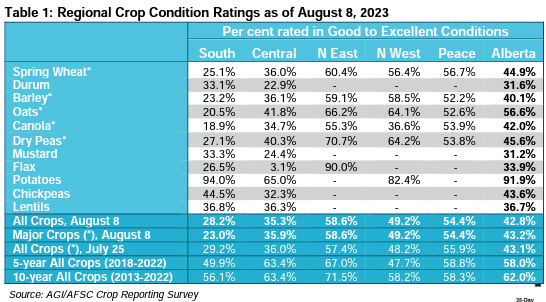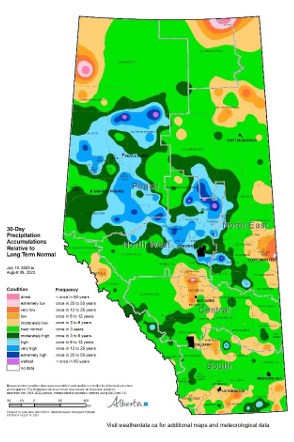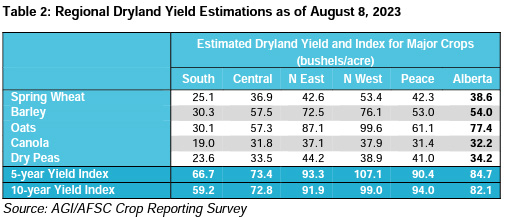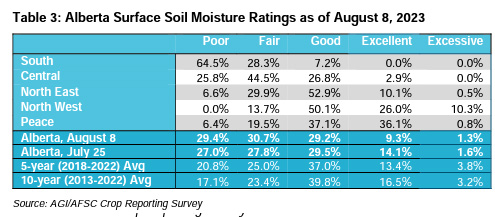Alberta Crop Report as of August 8, 2023

Crop Report, provided by the Government of Alberta Agriculture and Irrigation, as of August 8, 2023:
Precipitation in the past 30 days has been near normal for the majority of the province. The Peace and North West Region have experienced once in 6-to-12-year highs while small pockets across the province have received once in 3-to-25-year lows as seen on the map below. These scattered showers have helped crop maturing slow down and spring cereals are on average in early dough stage, fairly on track with the 5- and 10-year average. Similarly, podding of broadleaf crops is at 89 per cent complete across the province, consistent with the 5-year average.
Provincially, conditions rated good to excellent are currently at 43 per cent, 15 and 19 per cent below the 5- and 10-year average respectively. These conditions are stable from the last report on July 25. Regionally, only the North East and North West Regions saw an increase in conditions rated good to excellent as they both increased by 1 per cent while the South, Central and Peace Regions saw decreases of 1 to 2 per cent. The poorest rated regions remain the South and Central which are 22 and 28 per cent below their 5-year average, respectively. The North East and Peace are 8 and 4 per cent below their 5-year averages, respectively. The North West is the only region above their 5-year average at 2 per cent above.
Harvest progress has begun in both the South and Central Regions. Currently, 11 per cent of the crop is combined in the South, 7 per cent ahead of the 5-year average. Only 2 per cent of the crop is harvested in the Central Region, consistent with the 5year average. Fall-seeded crops and pulses are currently being combined.


The majority of yield estimates are below both the 5- and 10-year averages in all regions except the Peace Region. Provincially, the estimated dryland 5-year yield index of major crops is 84.7, indicating that provincial yields are estimated at 15.3 per cent below the 5year averages (See Table 2). Regionally, the 5-year yield index is the best in the North West Region where yields are estimated to be 7.1 per cent above the 5-year averages. The next highest are the North East and the Peace Regions where yields are 6.7 and 9.6 per cent below the 5-year averages, respectively. The 5-year yield index estimates are reported the lowest in the South and Central where they are 33.3 and 26.6 per cent below the 5-year average, respectively. The strongest 5-year yield index estimates are for winter wheat, oats and mixed grains; the poorest are for fall rye, spring triticale and chickpeas.
Table 2 below contains bushel/acre yield estimates for major crops across regions. The 5-year yield index can be interpreted as the following; if the estimated dryland 5-year yield index of major crops in the South Region is 66.7, that indicates that provincial yields are estimated at 33.3 per cent below the 5-year averages or 66.7 per cent of the 5-year average.

While surface soil conditions were quite stable from the end of June until the beginning of August, conditions have declined 5 per cent from last report. Currently, 39 per cent of the province is rated to have good to excellent surface soil moisture. Surface soil moisture is rated 29 per cent poor, 31 per cent fair, 29 per cent good, 9 per cent excellent and 1 per cent excessive. The South and Central Regions have very dry conditions, while 10 per cent of the North West Region is rated as having excessive soil moisture. Sub-surface soil moisture is rated as 36 per cent good to excellent, down four per cent from last report. Provincial sub-surface soil moisture is rated as 31 per cent poor, 33 per cent fair, 28 per cent good, and 8 per cent excellent.

Pasture and tame hay growing conditions have been slowly decreasing since the beginning of the growing season and both fell another two per cent (rated good to excellent) since the last report. Provincially, pasture growth conditions are rated 36 per cent poor, 35 per cent fair, 28 per cent good, and 1 per cent excellent. Tame hay is rated 28 per cent poor, 37 per cent fair, 33 per cent good, and 3 per cent excellent. Provincially, 95 per cent of dryland hay is cut with an average yield of 0.9 tons per acre, down from the 5-year average of 1.4 tons per acre. The highest yield estimates were from the Peace (1.1 tons per acre) and the lowest was in the South (0.8 tons per acre). Provincially, 40 per cent of acres are estimated to get a second cut and are currently 9 per cent complete, also averaging 0.9 tons per acre. First cut irrigated hay in the South and Central Regions is complete and second cut is 16 per cent completed. Both first and second cut irrigated hay estimated yields are 2 tons per acre, similar to the 5-year averages of 2.2 and 1.7 tons per acre, respectively. Due to poor annual crop conditions, there are reports of some crops being cut for feed, especially in the Central Region.
Region Five: Peace (Fairview, Falher, Grande Prairie, Valleyview)
- Spring cereal staging is on track with the 5-year average in early dough stage and 97 per cent of all broadleaves are podding, 11 per cent ahead of the 5-year average.
- Surface soil moisture (sub-surface soil moisture in brackets) is currently rated at 6 (5) per cent poor, 20 (19) per cent fair, 37 (40) per cent good, 36 (36) per cent excellent and 1 (0) per cent excessive.
- First cut dryland hay is 92 per cent complete and estimated yields are averaging 1.1 tons per acre, below the 5-year average of 1.4 tons per acre.
- Pasture growth conditions (tame hay conditions in brackets) are rated as 15 (15) per cent poor, 38 (38) per cent fair, 41 (41) per cent good, and 6 (6) per cent excellent.
To read the full report on all regions head to their website: https://open.alberta.ca/publications/2830245
Contact Us
Saddle Hills
Junction of Hwy 49 & Secondary Hwy 725
RR1, Spirit River AB
T0H 3G0
T. 780-864-3760
Fax 780-864-3904
Toll-free 1-888-864-3760
frontdesk@saddlehills.ab.ca
Sign up to our Newsletter
Stay up to date on the Saddle Hills activities, events, programs and operations by subscribing to our eNewsletters.
